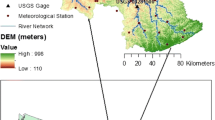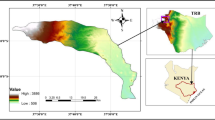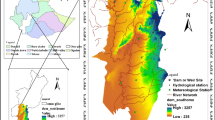Abstract
Ecohydrologic models are a key tool in understanding plant–water interactions and their vulnerability to environmental change. Although implications of uncertainty in these models are often assessed within a strictly hydrologic context (for example, runoff modeling), the implications of uncertainty for estimation of vegetation water use are less frequently considered. We assess the influence of commonly used model parameters and inputs on predictions of catchment-scale evapotranspiration (ET) and runoff. By clarifying the implications of uncertainty, we identify strategies for insuring that the quality of data used to drive models is considered in interpretation of model predictions. Our assessment also provides insight into unique features of semi-arid, urbanizing watersheds that shape ET patterns. We consider four sources of uncertainty: soil parameters, irrigation inputs, and spatial extrapolation of both point precipitation and air temperature for an urbanizing, semi-arid coastal catchment in Santa Barbara, CA. Our results highlight a seasonal transition from soil parameters to irrigation inputs as key controls on ET. Both ET and runoff show substantial sensitivity to uncertainty in soil parameters, even after parameters have been calibrated against observed streamflow. Sensitivity to uncertainty in precipitation manifested primarily in winter runoff predictions, whereas sensitivity to irrigation manifested exclusively in modeled summer ET. Neither ET nor runoff was highly sensitive to uncertainty in spatial interpolation of temperature. Results argue that efforts to improve ecohydrologic modeling of vegetation water use and associated water-limited ecological processes in these semi-arid regions should focus on improving estimates of anthropogenic outdoor water use and explicit accounting of soil parameter uncertainty.











Similar content being viewed by others
References
Anderson JR, Hardy EE, Roach JT, Witmer RE. 1976. A land use and land cover classification system for use with remote sensor data. US Geological Survey, Professional Paper 964. Reston, VA: USGS.
Austin AT, Yadijan L, Stark JM, Belnap J, Porporato A, Norton U, Ravetta DA, Schaeffer SM. 2004. Water pulses and biogeochemical cycles in arid and semiarid ecosystems. Oecologia 141:221–35.
Band L, Moore I. 1995. Scale-landscape attributes and geographical information systems. Hydrolo Proc 9:401–22.
Bardossy A, Das T. 2008. Influence of rainfall observation network on model calibration and application. Hydrol Earth Syst Sci 12:77–89.
Beighley R, Dunne T, Melack J. 2005. Understanding and modeling basin hydrology: interpreting the hydrogeological signature. Hydrol Proc 19:1333–53.
Beven K, Binley A. 1992. The future of distributed models—model calibration and uncertainty prediction. Hydrol Proc 6:279–98.
Beven K, Freer J. 2001. Equifinality, data assimilation, and uncertainty estimation in mechanistic modelling of a complex environmental system using the GLUE methodology. J Hydrol 249:11–29.
Cao WZ, Bowden WB, Davie T, Fenemor A. 2006. Multi-variable and multi-site calibration and validation of SWAT in a large mountainous catchment with high spatial variability. Hydrol Proc 20:1057–73.
Cayan D, Maurer EP, Dettinger MD, Tyree M, Hayhoe K. 2008. Climate change scenarios for the Californian region. Clim Change 87:21–42.
Choi H, Beven K. 2007. Multi-period and multi-criteria model conditioning to reduce prediction uncertainty in an application of TOPMODEL within the GLUE framework. J Hydrol 332:316–36.
County of Santa Barbara. 2007. Santa Barbara County water purveyors water shortage contingency/drought planning handbook. http://www.countyofsb.org/pwd/water/downloads/HandbookforPurveyorsRevSep2007.pdf.
Dettinger M, Redmond K, Cayan D. 2004. Winter orographic precipitation ratios in the Sierra Nevada—large-scale atmospheric circulations and hydrologic consequences. J Hydrometeorol 5:1102–16.
Fuentes M, Kittel TGF, Nychka D. 2006. Sensitivity of ecological models to their climate drivers: statistical ensembles for forcing. Contemp Stat Ecol 16:99–116.
Fischer DT, Still CJ, Williams AP. 2009. Significance of summer fog and overcast for drought stress and ecological functioning of coastal California endemic plant species. J Biogeogr 36:783–99.
Gleick P, Haasz D, Henges-Jeck C, Srinivasan V, Wolff G, Cushing KK, Mann A. 2003. Waste not, want not: the potential for urban water conservation in California. Pacific Institute for Studies in Development, Environment, and Security, Oakland.
Hevesi J, Flint A, Istok J. 1992. Precipitation estimation in mountainous terrain using multivariate geostatistics 2 isohyetal maps. J Appl Meteorol 31:677–88.
Holden J. 2009. Topographic controls upon soil macropore flow. Earth Surf Proc Land 34:345–51.
IPCC. 2007. Contribution of Working Groups I, II, and III to the Fourth Assessment Report of the Intergovernmental Panel on Climate Change, Geneva, Switzerland.
Irmak S, Payero JO, Martin DL, Irmak A, Howell TA. 2006. Sensitivity analyses and sensitivity coefficients of standardized daily ASCE-Penman Monteith equation. J Irrig Drain Eng-ASCE 132:564–78.
Johnson T. 2005. Predicting residential irrigation amounts using remote sensing in Los Angeles, California. M.S. thesis. San Diego, CA: San Diego State University.
Jones H. 1992. Plants and microclimate. 2nd edn. Cambridge: Cambridge University Press.
Kirchner J. 2006. Getting the right answers for the right reasons: Linking measurements, analyses, and models to advance the science of hydrology. Water Resour Res 42:W03S04.
Kumar S, Sekhar M, Reddy DV, Kumar MSM. 2010. Estimation of soil hydraulic properties and their uncertainty: comparison between laboratory and field experiment. Hydrol Proc 24:3426–35.
Mackun P, Wilson S. 2011. Population Distribution and Change: 2000 to 2010, U.S. Census Bureau, U.S. Department of Commerce, Economics and Statistics Administration.
Mair A, Fares A. 2011. Comparison of rainfall interpolation methods in a mountainous region of a tropical island. J Hydrol Eng 16:371–83.
Metropolitan Water District. 1996. Integrated Water Resources Plan (IRP), MWD report no. 1107.
Moulin L, Gaume E, Obled C. 2009. Uncertainties on mean areal precipitation: assessment and impact on streamflow simulations. Hydrol Earth Syst Sci 13:99–114.
Miller AE, Schimel JP, Meixner T, Sickman JO, Melack JM. 2005. Episodic rewetting enhances carbon and nitrogen release from chaparral soils. Soil Biol Biogeochem 37:2195–204.
Nandakumar N, Mein R. 1997. Uncertainty in rainfall-runoff model simulation and the implications for predicting the hydrologic effects of land-use change. J Hydrol 192:211–32.
Nash JE, Sutcliffe JV. 1970. River flow forecasting through conceptual models part I—A discussion of principles. J Hydrol 10:282–90.
Nieber J, Sidle R. 2010. How do disconnected macropores in sloping soils facilitate preferential flow? Hydrol Proc 24:1582–94.
Ochoa-Hueso R, Manrique E. 2010. Nitrogen fertilization and water supply affect germination and plant establishment of the soil seed bank present in a semi-arid Mediterranean scrubland. Plant Ecol 210:263–73.
Paul M, Meyer J. 2001. Streams in the urban landscape. Annu Rev Ecol Syst 32:333–65.
Priestley C, Taylor R. 1972. On the assessment of surface heat flux and evaporation using large-scale parameters. Mon Weather Rev 100:81–2.
Running S, Nemani R, Hungerford R. 1987. Extrapolation of synoptic meteorological data in mountainous terrain and its use for simulating forest evapotranspiration and photosynthesis. Can J For Res 17:472–83.
Serat-Capdevila A, Scott RL, Shuttleworth WJ, James W. 2011. Estimating evapotranspiration under warmer climates: insights from a semi-arid riparian system. J Hydrol 399:1–11.
Sivapalan M. 2009. The secret to ‘doing better hydrological science’: change the question!. Hydrol Proc 23:1391–6.
Spruill CA, Workman SR, Taraba JL. 2000. Simulation of daily and monthly stream discharge from small watersheds using the SWAT model. Trans ASAE 43:1431–9.
Tague C, Pohl M. 2008. The utility of physically based hydrologic modeling in ungaged urban streams. Ann Assoc Am Geogr 93:1–16.
Tague C, McMichael C, Hope A, Choate J, Clark R. 2004. Application of the RHESSys model to a California semiarid shrubland watershed. JAWRA J Am Wat Resour Assoc 40:575–89.
Tague C, Seaby L, Hope A. 2009. Modeling the eco-hydrologic response of a Mediterranean type ecosystem to the combined impacts of projected climate change and altered fire frequencies. Clim Change 93:137–55.
Tague C, Band L. 2004. RHESSys: regional hydro-ecologic simulation system—an object-oriented approach to spatially distributed modeling of carbon, water, and nutrient cycling. Earth Interact 8:1–42.
van Wijk M. 2011. Understanding plant rooting patterns in semi-arid ecosystems: an integrated model analysis of climate, soil type, and plant biomass. Glob Ecol Biogeogr 20:331–42.
Wagener T, Wheater HS. 2006. Parameter estimation and regionalization for continuous rainfall-runoff models including uncertainty. J Hydrol 320:132–54.
Ward A, Trimble S, Wolman M. 1994. Environmental hydrology. 2nd edn. Boca Raton: CRC Press.
White MA, Thornton PE, Running SW, Nemani RR. 1997. Parametrization and sensitivity of the BIOME-BGC terrestrial ecosystem model: net primary production controls. Earth Interact 4:1–85.
White M, Greer K. 2006. The effects of watershed urbanization on the stream hydrology and riparian vegetation of Los Penasquitos Creek, California. Landsc Urban Plan 74:125–38.
Williams A, Still CJ, Fischer DT, Leavitt SW. 2008. The influence of summertime fog and overcast clouds on the growth of a coastal Californian pine: a tree-ring study. Oecologia 156:601–11.
Winsemius HC, Savenjie HHG, Bastiaanssen WGM. 2008. Constraining model parameters on remotely sensed evaporation: justification for distribution in ungauged basins? Hydrol Earth Syst Sci 12:1403–13.
Winsemius H, Schaefli B, Montanari A, Savenije HHG. 2009. On the calibration of hydrological models in ungauged basins: a framework for integrating hard and soft hydrological information. Wat Resour Res 45:W12422.
Xiang SR, Doyle A, Holden PA, Schimel JP. 2008. Drying and rewetting effects on C and N mineralization and microbial activity in surface and subsurface California grassland soils. Soil Biol Biogeochem 40:2281–9.
Zhu AX, Hudson B, Burt J, Lubich K, Simonson D. 2001. Soil mapping using GIS, expert knowledge, and fuzzy logic. Soil Sci Soc Am J 65:1463–72.
Acknowledgments
This research was supported by a National Science Foundation Graduate Research Fellowship, and by the Santa Barbara Coastal Long-Term Ecological Research project, funded by the National Science Foundation (OCE-9982105 and OCE-0620276). We thank the two anonymous reviewers whose extensive and thoughtful comments greatly contributed to the quality of the final manuscript.
Author information
Authors and Affiliations
Corresponding author
Additional information
Author Contributions
The study was conceived and designed as a joint effort by C. Tague and C. Shields. Research and data analysis was performed primarily by C. Shields, with substantial assistance from C. Tague. C. Shields wrote the paper, again with substantial assistance from C. Tague.
Rights and permissions
About this article
Cite this article
Shields, C.A., Tague, C.L. Assessing the Role of Parameter and Input Uncertainty in Ecohydrologic Modeling: Implications for a Semi-arid and Urbanizing Coastal California Catchment. Ecosystems 15, 775–791 (2012). https://doi.org/10.1007/s10021-012-9545-z
Received:
Accepted:
Published:
Issue Date:
DOI: https://doi.org/10.1007/s10021-012-9545-z




